
 |
Dextra Quotskuyva |
The creamy color of the seed jar is typical of Hopi clay, which is gray before firing but turns shades from cream or yellow to apricot or light red, depending on its iron content and the amount of OXIDATION in the firing. The jar has a minimal amount of painted design. Quotskuyva says that sometimes "that is all the pot wants, and you have to let it go."3 She adds her own unique variations to ancient patterns that originated between 1375 and 1625 at Sikyatki (seek-YAHT-kee), an abandoned Hopi village. Sikyatki designs inspired the ABSTRACT and GEOMETRIC forms of the jar; its triangles, rectangles, parallel lines, and spirals traditionally represent rain, lightening, and wind. The cluster of precisely painted, abstract forms restricted to one shoulder complements the jar's shape. Quotskuyva wants people to touch her pots and experience the way they feel. This jar, like other Sikyatki shapes, almost defies the laws of structure with its wide flattened shoulder and small opening in the center.
The seed jar also contains distinguishing Nampeyo family MOTIFS, such as STYLIZED bird wings and feathers. Three triangular-capped feathers sweep across the top of the jar and fan out to the left side of the design as if fancifully blown by the wind. Farther to the right, in contrast, an angular wing of split feathers is expressed more solidly and geometrically. Birds, especially eagles, play an important ceremonial role in the life of the Hopi people. The arid land of the mesas requires ample rainful to produce the crops of corn, melons, peaches, gourds, squash, and beans that the Hopi rely upon. They believe the spirit of the eagle carries a prayer for rain to the gods on behalf of the people.4
Several Hopi designs and painting methods were rediscovered in the late 1800s, when archaeologists unearthed potteries from the ruins of Sikyatki. Nampeyo, Quotskuyva's great-grandmother, decided to reintroduce the old Sikyatki designs found on excavated potsherds. She succeeded in reviving the style, rediscovered old clay sources, and abandoned the use of slip to polish the yellow clay body itself. Many Pueblo women and their families followed her lead; they still tell stories of her teaching and influence.
Notes
3. Struever, "Potter Dextra Quotskuyva," p. 60.
4. Young eaglets are captured and tethered to the rooftops of village houses to observe whether the villagers are carrying out their obligations. At the end of its watch, the bird is sacrificed so that its spirit can soar to the heavens with the message that all is well and the rains may continue to come. See Susanne and Jake Page, Hopi (New York: Harry N. Abrams, 1994), for the complete story on pp. 191-196.

Key ideas.
Where does it come from?
What does it look like?
How was it used?
How was it made?
Discussion questions.
Additional resources.
Select another piece.